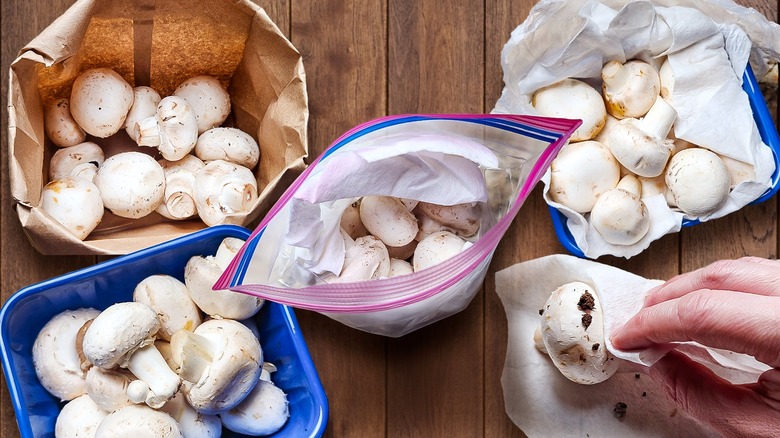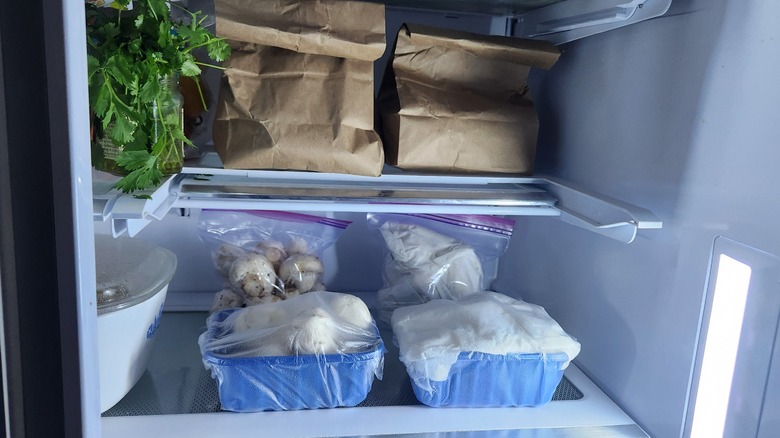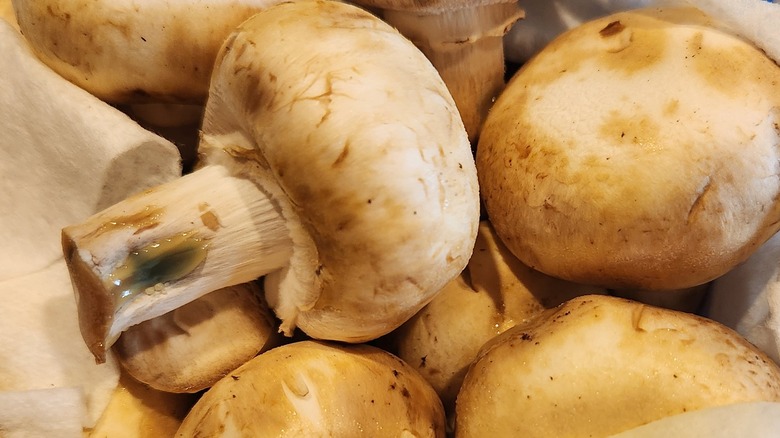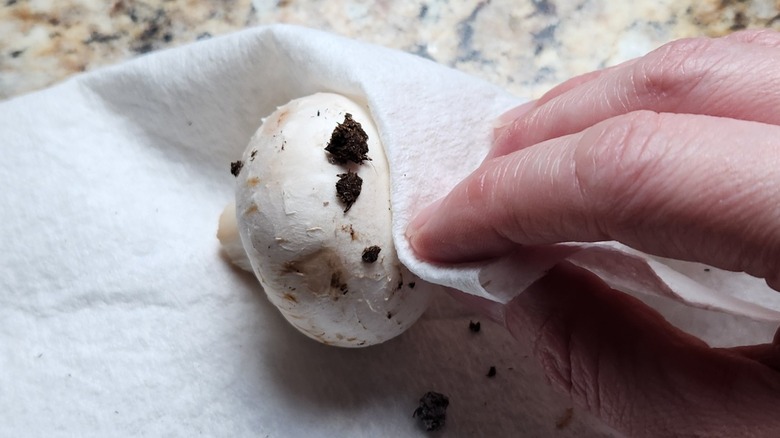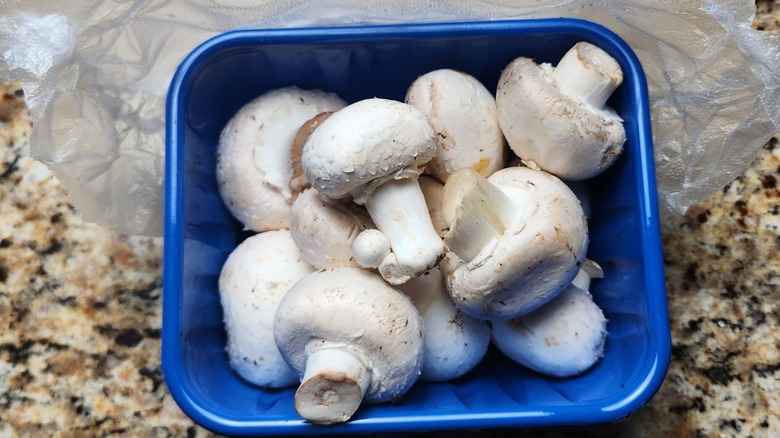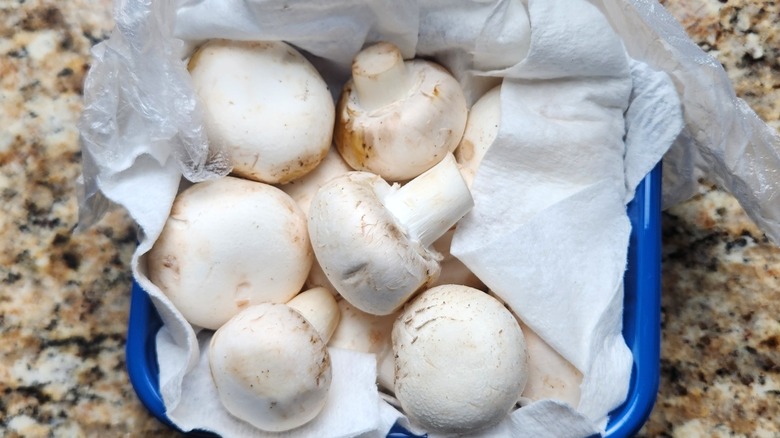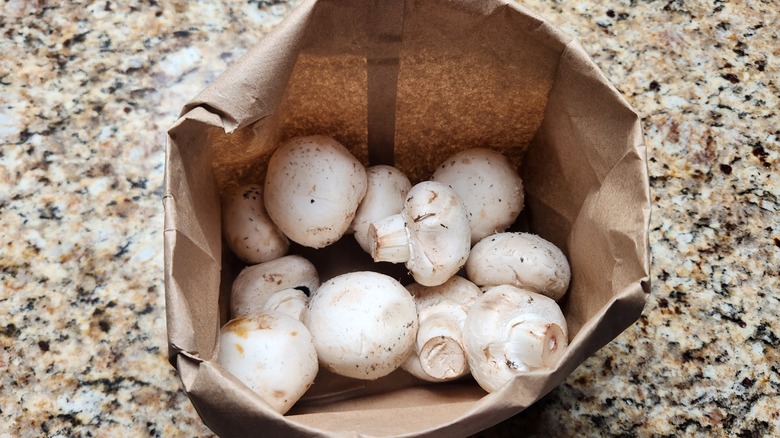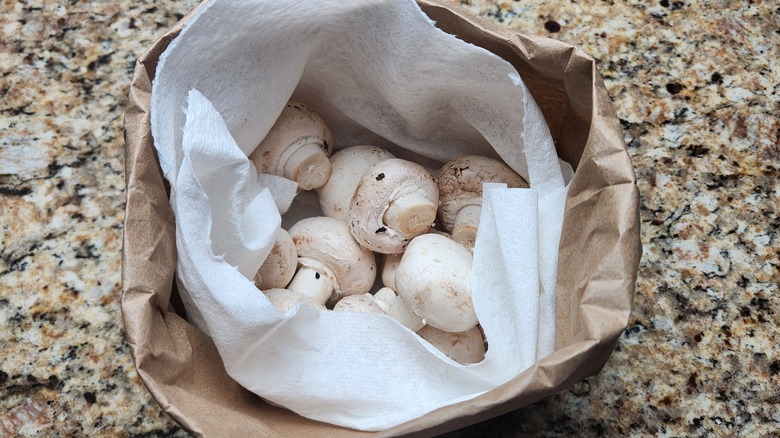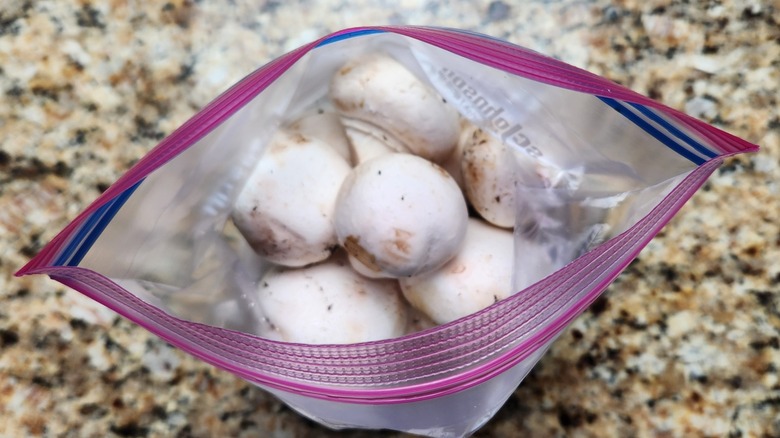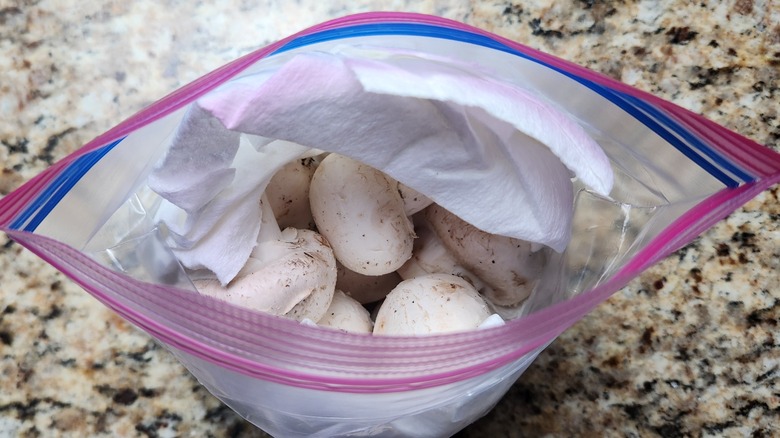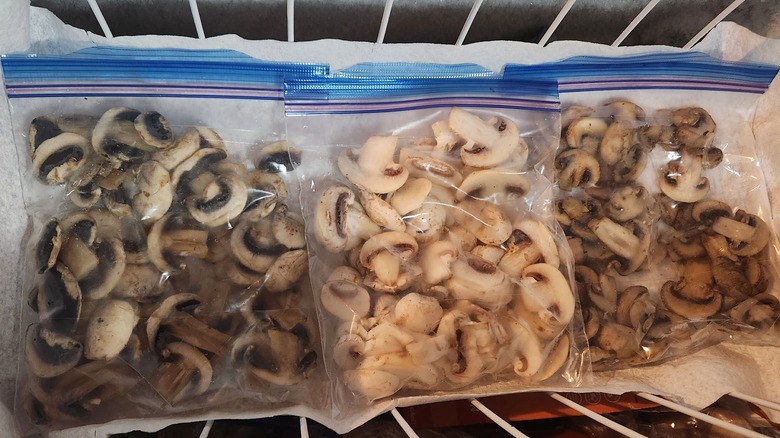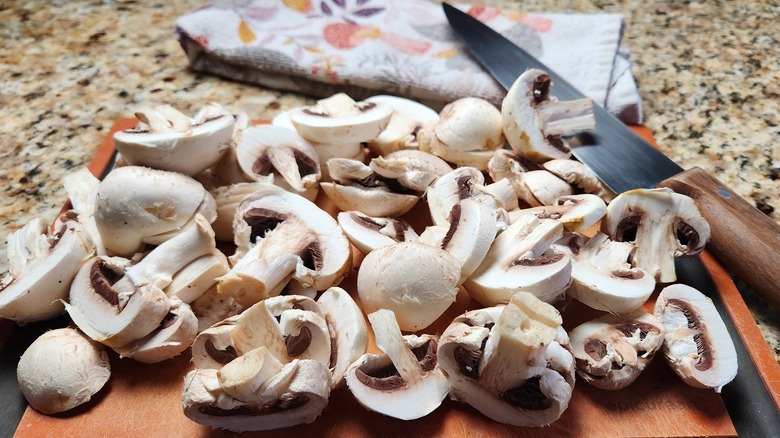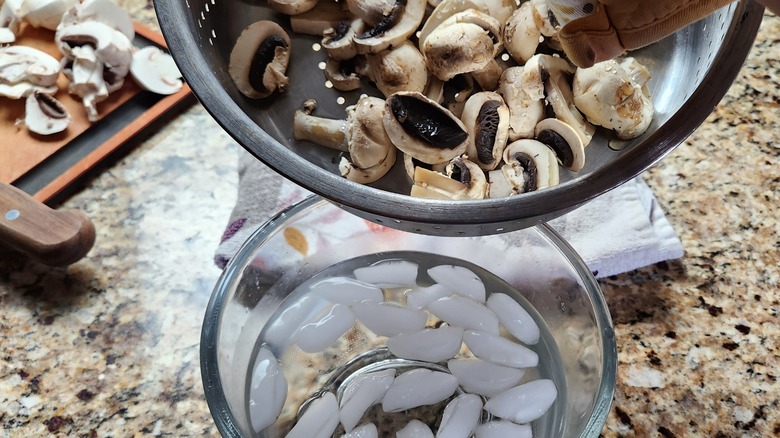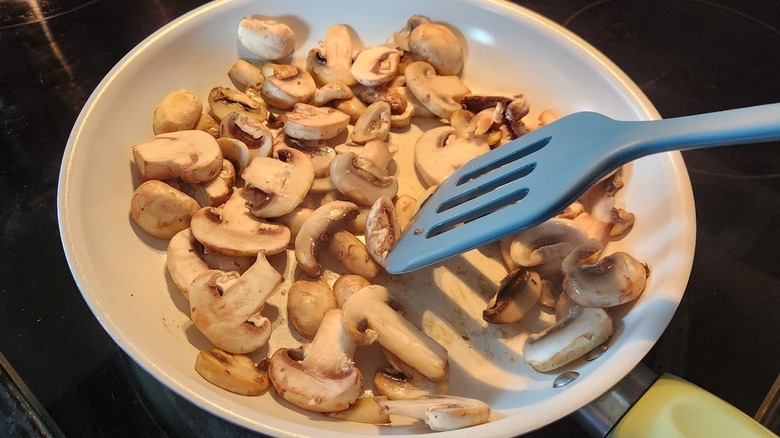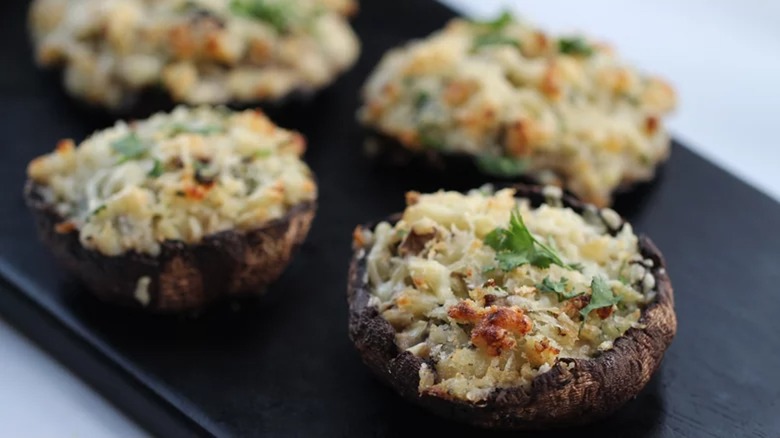How To Store Mushrooms 9 Different Ways
The way you store mushrooms makes a big difference in how long they last and how good their texture and flavor remains after spending time in the fridge or freezer. If you'd rather not throw out more mushrooms than you use, it's good to know which storage methods are best and which ones to avoid.
To identify the best ways for storing mushrooms, I tested nine different methods: six were in the fridge and three were in the freezer. For the fridge experiments, I tried storing the mushrooms whole in their original container, in a plastic zipper bag, and in a paper bag — both with and without being wrapped in paper towels. For the freezing method, I tried storing sliced mushrooms in a freezer bag in three different states: raw, steam blanched, and sauteed.
At the end of 10 days, I observed how the refrigerated mushrooms had changed and how the frozen ones fared when cooked. I was actually surprised about the results I ended up with regarding the best and worst storage methods. You'll want to read on to learn what to do and what not to do when storing mushrooms for optimal freshness.
How long can you store mushrooms?
If you use the right method for storing mushrooms, you can keep them for a reasonable amount of time before they're likely to go bad. With your fridge at the optimal temperature (40 degrees Fahrenheit or below, per the FDA), you should expect whole mushrooms to last at least four to seven days before they start showing signs of deterioraton. However, sliced raw mushrooms won't last nearly as long in the fridge — only one or two days.
While the texture won't be as nice, you can also store mushrooms in your freezer for even longer. It's best to consume them within a month of when frozen, though they can last for 10 to 12 months. They'll still be safe beyond the one-year mark, but the quality won't be as good. If your freezer is at 0 degrees Fahrenheit, you can keep them frozen indefinitely. It's worth noting that frozen mushrooms aren't as nutrient-dense as fresh ones, since some water-soluble nutrients will decrease over time in the freezer.
How to tell if mushrooms have gone bad in the fridge
When we look at how long mushrooms last, what we're really looking at is how long it's likely to take before they start going bad. So, they could last for a shorter or longer duration depending on how you store them.
How do you tell if your mushrooms have gone bad? Trust your senses. Bad fungi may start to look discolored or shriveled. If they're bruising, have dark spots, or start to turn darker than they originally were, they're on their way out. You might also notice they smell bad. If they have a fishy odor or anything besides their normal earthy notes, it's time to toss them out. The bad smell may be coming from bacteria that could make you sick. You can also detect problems by feeling the mushrooms. When they are stored with too much moisture, they will start to become sticky or slimy. To be on the safe side, it's best to trash them rather than chance them making you sick.
The repercussions of eating spoiled mushrooms can be pretty bad. If they're contaminated with Botulism, Salmonella, Listeria, Staphylococcus, E. coli, or other bacteria, they can make you very sick or even kill you. So, if you have any doubts, don't eat them (especially not raw).
What to do before storing mushrooms in the fridge
When it comes to storing mushrooms in the fridge, there are a few important steps to take to ensure they don't spoil faster than necessary. Most involve cleaning and keeping them dry. The mushrooms you get from the store or while foraging will be dirty — after all, they grow in dirt. However, you shouldn't wash them before storing if you want to increase their shelf life.
Instead, plan to rinse them before cooking. Because they're porous, water is easily absorbed. The less moisture you introduce, the better your chances of avoiding spoilage for longer. If you do end up rinsing your mushrooms — like with foraged ones carrying insect guests — be sure to dry them well before storing. You could use a salad spinner to speed the drying process if they aren't too delicate. Some fragile varieties, like chanterelles, benefit from drying on butcher paper on the counter overnight instead.
A mushroom brush or a paint brush can be your friend here if you want to knock off some dirt clods before refrigerating. Scraping is also a possibility. If insects are an issue, keep in mind that you can kill off unwanted insects with an eight-hour stint in an airless plastic bag in the fridge instead of soaking the mushrooms in water.
Method 1: Storing mushrooms in the fridge in the original plastic-covered container
Probably the most intuitive thing you can do when you bring mushrooms home is to store them in the original container in the refrigerator — but it's not the best option. The mushrooms at my grocery store come in a plastic container wrapped with plastic. Since I was experimenting with another method of storing mushrooms in the original plastic container, I switched to the same type of plastic wrap for both containers to make the conditions equal .
After 10 days, there was a lot of condensation inside the plastic wrap. There were a few areas on some of the mushrooms that were turning light brown, but they were only really noticeable with close scrutiny. Unfortunately, a third of the mushrooms were touching the wet plastic wrap and became slimy over time. That left two-thirds that still looked, felt, and smelled like they would be safe to eat.
While storing mushrooms in the fridge covered in plastic in their original container isn't the best choice, it's also not the worst option. Once you toss out the slimy ones, there is still a good amount remaining a few days past the one-week mark.
Method 2: Storing mushrooms in the fridge in the original plastic-covered container with paper towels
The second refrigerator method I tried was storing the mushrooms in the original container, wrapped in paper towels. Then I covered it all in plastic wrap. The paper towels kept down the condensation, but it was far from being the best storage option. While it seemed like a great plan, it was an absolute disaster.
A couple of days after I put the paper-towel-wrapped mushrooms back in their plastic container, I started noticing something green bleeding through. After 10 days, I finally took a look at what was happening inside the container. A third of the mushrooms were oozing with green slime, including both those that were and weren't touching the plastic wrap. In addition to the green slime, all of the mushrooms were turning noticeably brown, and every last one of them was slimy with the regular type of mushroom slime.
There was no doubt that all of these mushrooms needed to go straight into the trash. Even if they hadn't been contaminated with a bacteria causing the green slime, they still stayed wet enough to become covered with standard slime. So, these were by far the worst of all the ones in my experiment. You're far better off keeping mushrooms in the container without a paper towel, which was not my original expectation.
Method 3: Storing mushrooms in the fridge in a paper bag
The idea behind storing mushrooms in the fridge in a paper bag is to help soak up some of the condensation instead of having it condense on the bag. Because I didn't want the bag to become contaminated by anything that spilled in the fridge, I put both paper bags for my experiment in an open plastic tub.
After 10 days, I noticed the tub had condensation on the bottom of it, and the bag was slightly damp. However, the mushrooms were all in pretty good shape. A few were starting to develop light brown spots, but none were remotely slimy. They all smelled fine, too. While I wouldn't notice the brown spots if I wasn't conducting this experiment, the spots still indicate a slight drop in quality. Honestly, I'd have zero reservations about cooking with them, even on day 10.
Method 4: Storing mushrooms in the fridge in a paper bag with paper towels
The mushrooms stored in a paper bag wrapped in paper towels fared just as well as the ones alone in the bag. In this case too, the paper bag was slightly damp at the end of the duration. However, that didn't seem to really affect what was going on with the mushrooms.
A few light brown spots were starting to form on the surface, but they were barely noticeable, and there was no slime or bad smells. The mushrooms really didn't look that different from when I put them into the bag in the first place.
Both paper bag storage options — with and without paper towel — seemed fairly equal overall. They didn't end up being the best method I found for storing mushrooms in the fridge, but they tied for a very close second place.
Method 5: Storing mushrooms in the fridge in a plastic bag
Another technique I used for storing mushrooms in the fridge was in a plastic bag with a zipper closure. Before I sealed the bag, I made sure to suck the air out of it with a straw to give them the best chance of staying fresh. However, it didn't work quite like I expected.
I wasn't very hopeful about this method because there was condensation inside the bag on day one. By day 10, most mushrooms (10 out of 12) were slimy. One had turned very dark. With only two of the mushrooms still in good shape, it wasn't the worst storage option, but it was pretty close. With nearly all the mushrooms in constant contact with the moisture inside the bag, most of them didn't stand a chance.
Overall, I wouldn't recommend storing your mushrooms in the fridge in a plastic bag alone. The environment is just too damp for them to keep very long.
Method 6: Storing mushrooms in the fridge in a plastic bag with paper towels
While refrigerating your mushrooms alone in a plastic bag is one of the worst options, storing them in a plastic bag with paper towels seems to be the best. I made sure to completely wrap the mushrooms with paper towels to soak up any dampness in the bag. Once they were all completely wrapped, I sucked the air out of the bag with a straw so air wouldn't factor into the equation. Unlike the bag of mushrooms without the paper towel, this one didn't have condensation on day 10.
Surprisingly, on day 10, the mushrooms looked, smelled, and felt exactly like they did when I put them in the bag. There was no slime or discoloration on any of them. The next time I buy mushrooms, I'll be transferring them directly into plastic bags and wrapping them with paper towels to keep them fresh as long as possible.
What to do before storing mushrooms in the freezer
When freezing mushrooms, it's important to note they're 80% to 90% water. Consequently, the texture just won't be the same as eating them fresh. I saw lots of suggestions for either steam-blanching or sauteeing mushrooms before freezing, so I tested those theories here along with freezing them raw.
Before storing mushrooms in the freezer, they need some prep. You'll want to brush off any dirt with a paper towel since you'll be taking them straight from the freezer to the frying pan. I found that slicing them about ¼ inch thick is best. If you're pre-cooking them using water or oil, they'll need to be drained on a paper towel and blotted dry to minimize moisture.
To avoid clumping, I also decided to first freeze them flat before transferring them to plastic freezer bags. To do this, I placed the prepared mushroom slices in a single layer in a casserole dish covered with waxed paper and froze them for about an hour until they were slightly hard. You could also use a plate or tray covered in waxed paper.
Method 7: Storing raw mushrooms in the freezer in a freezer bag
Freezing mushrooms raw is probably the easiest option if you have more than you can eat before they go bad. While this method takes the least amount of effort, it only yields mediocre results when cooked. To prepare the mushrooms for freezing, I sliced and pre-froze them flat in a glass casserole dish covered with wax paper. Then, I stuck them in the freezer for about an hour until they were slightly hardened. I used a straw to suck the air out before sealing them in a good-quality plastic freezer bag and placing them back in the freezer.
To test, I took a handful of mushrooms out of the bag on day 10 and threw them (still frozen) straight onto a hot skillet with olive oil and a little salt. Since they started raw and frozen, they needed about 5 minutes of saute time, turning them halfway through. The resulting mushrooms weren't as soggy or chewy as I expected, but there was still a bit more rubberiness than you would experience with fresh sauteed mushrooms. However, I didn't much care for the flavor, as they were earthier and sweeter tasting than expected. They'd do in a pinch but would certainly taste better cooked with other ingredients.
Method 8: Storing steam-blanched mushrooms in the freezer in a freezer bag
I found several sources that suggested steam-blanching mushrooms before freezing them. In the end, this turned out to be the worst freezer storage method I tested. I started by slicing the mushrooms and steaming them in a steamer basket over a pot of boiling water for 3 to 5 minutes. After they were done, I plunged them into ice water for 3 to 5 minutes to stop the cooking process. With this method, the mushrooms took on a lot of liquid, so I drained them on paper towels and blotted them dry before pre-freezing them flat for about an hour. Then, I transferred them into an airless freezer bag to hang out in the freezer for a while.
On day 10 of the experiment, I tried sauteeing the mushrooms in a skillet with a little olive oil and salt, immediately after taking them out of the freezer. Since they were pre-cooked with the steam-blanching process, they only needed about 3 minutes total to warm through on each side. While the flavor was nice, the texture was not. In fact, they were so rubbery I could barely chew them. It's easy to declare the steam blanching mushroom storage method for the freezer a complete failure. All that water in the prep process was a bad idea since mushrooms absorb liquid so easily.
Method 9: Storing quickly sauteed mushrooms in the freezer in a freezer bag
I also found several sources that suggested sauteeing mushrooms before putting them in the freezer. I tried that out for the third method for freezing mushrooms, and it turned out to be the best. I used olive oil for sauteeing since it doesn't have the same water content as butter. I sauteed the mushrooms for about 5 minutes, until they were soft and nearly done. Since they absorbed a lot of oil, I drained them between paper towels and blotted the oil before moving them to the freezer. I pre-froze them flat for about 30 minutes, then I transferred them to an airless freezer bag.
Ten days into my experiment, I dropped the still-frozen mushrooms straight into a skillet with a little olive oil. Since they were already cooked, they only needed about 3 minutes total to warm through on each side. The results were flavorful and the texture was nice. While there was a tiny bit of chewiness, it was barely noticeable. However, I found that the mushrooms I'd sliced more thinly (about ¼ inch) had a better texture, while the thicker ones were chewier because they had retained more water. While storing and cooking fresh mushrooms is the best option, if you need to freeze some before they go bad, this is the clear winner.
Recipes you can make to use up all your mushrooms
Since mushrooms have a short shelf life, it's a good idea to have a few mushroom recipes on the ready for when you realize they are nearing expiration. There are plenty of complicated recipes out there, but with a few basic ones in mind, you can avoid throwing out half a box of spoiled mushrooms for lack of inspiration.
One of the simplest ways to use up mushrooms is to make a topping for hamburgers. Mushroom and Swiss hamburgers are an excellent option, along with sauteed onions and barbecue sauce to add even more flavor. Don't forget that you could saute some mushrooms to quickly kick a fast-food burger up a notch, too.
Another option is to make hearty stuffed mushrooms. The filling comes together with minimal effort and consists of a soft cheese like cream cheese, Parmesan, breadcrumbs, parsley (or other herbs and seasonings of choice). Stuff and bake the mushrooms for 25 minutes at 350 degrees Fahrenheit and they're ready to serve. This recipe is simpler than you might think — especially if you opt for pre-grated and ready-to-use breadcrumbs.
